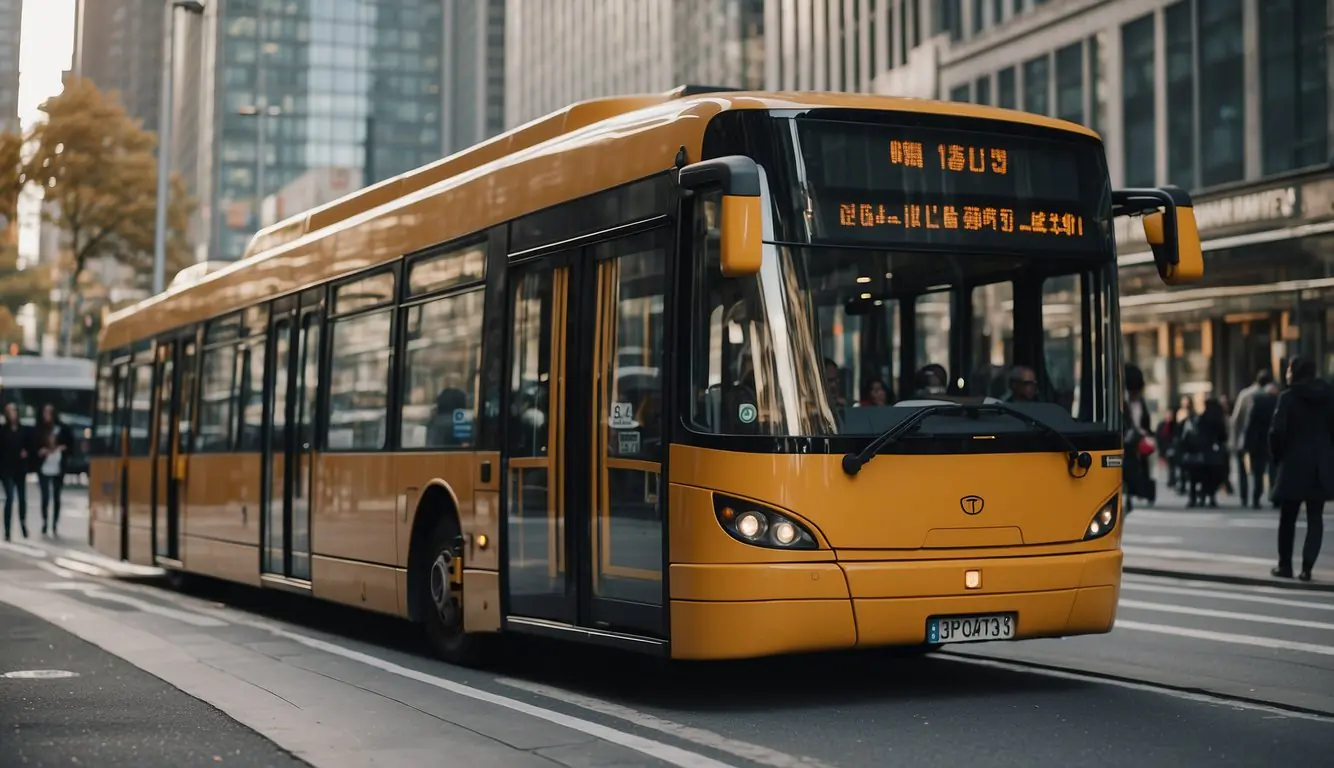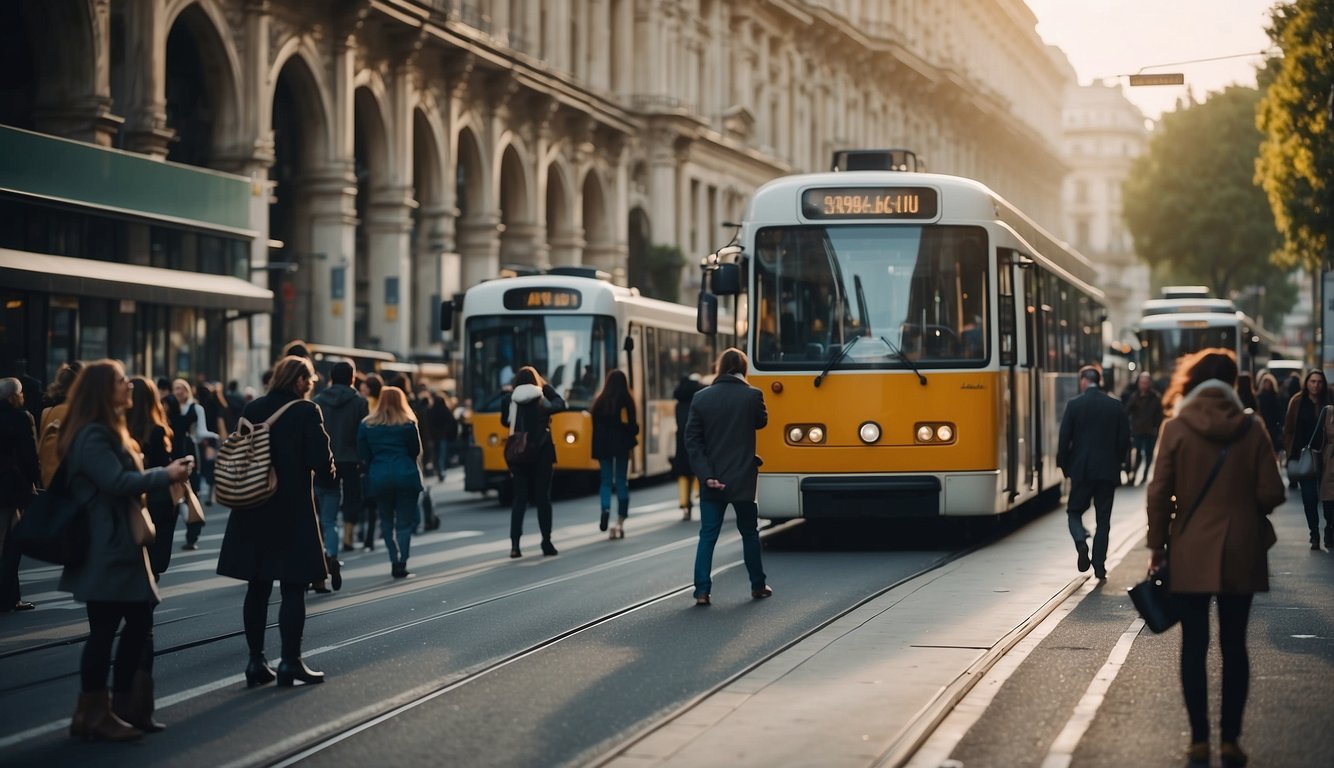Public transport in Milan is an essential network of trams, buses, and a subway system, all run by Azienda Trasporti Milanese (ATM). Serving both locals and tourists, these modes of transportation are integrated to facilitate movement across the city. Whether you are commuting for work or exploring Milan’s cultural sites, understanding the public transport system can enhance your experience of this vibrant Italian metropolis.

Our journey around Milan is made more accessible with the range of public transport tickets and passes available, which cater to various travel needs and offer cost-effective options for short and long stays. Additionally, technological advancements have given rise to convenient apps that streamline travel, allowing for real-time updates and ticket purchases on-the-go.
Public Transport in Milan
Key Takeaways
- Milan’s public transport system is a key facilitator for city navigation.
- An array of tickets and passes simplifies access to multiple transport modes.
- Technological tools assist in real-time travel planning and ticketing.
Overview of Milan’s Public Transport
Milan’s public transport system constitutes an intricate network of metro lines, trams, and buses, running through the heart of the city and extending to the outskirts. Travelers can navigate this system with ease, thanks in part to services like the ATM Milano Official App, which offers ticket purchasing and route planning tools.
History and Development of the Transport Network
Milan has seen its public transport evolve from horse-driven trams to the modern, electrically powered system we witness today. Azienda Trasporti Milanese (ATM) spearheaded this transition, overseeing the growth of services and routes that now serve as the lifeline of Milan’s mobility. The first metro line opened in 1964, marking a significant leap in connecting various districts swiftly and effectively.
Key Components of the Transport System
Integral to Milan’s public transport is the Metro, boasting a total of four lines: M1 (red), M2 (green), M3 (yellow), and M5 (purple). These lines link major spots throughout Milan, including the city center and the airports. The expansive network ensures comprehensive coverage, with additional support from suburban rail lines and an array of bus routes and trams, complementing the metro services across the urban sprawl. Purchase of tickets can be made via different means, ensuring accessibility and convenience for all travelers.
Understanding the Milanese Public Transport Tickets and Passes

Navigating Milan requires an understanding of the variety of tickets and passes available. To make the most of the city’s public transport, it’s important to know the options and how to use them.
Types of Tickets and Passes Available
Tickets and passes in Milan cater to different needs, whether you’re touring the city for a day or staying longer. A single ticket is valid for 90 minutes upon validation and allows multiple trips within the city’s fare zones, including changes between metro and surface transport.
For those planning more extensive travel, the daily ticket or day ticket provides unlimited travel for 24 hours. The three-day ticket offers the same convenience but is valid for 72 hours. For frequent travelers or residents, monthly passes serve as a more cost-effective solution.
Travel cards are also available, such as the MilanoCard, which includes public transport and discounts on city attractions.
Purchasing and Using Tickets and Passes
Tickets can be purchased at metro stations, via official ATM apps, or at authorized sellers throughout the city. Upon boarding a tram or bus, or entering the metro, you must validate your ticket. Keep in mind that both daily and single ticket validations are necessary to travel legally.
For travelers staying longer, travel cards can be a wise choice. They can be purchased online through Milan Public Transport or at any of the ATM points in the city. Always remember to carry your ticket with you, as fines for fare evasion are strict and enforced.
Make sure to check the latest information, as prices and options may vary.
Navigating the City
In Milan, the integration of various public transport methods, including the metro, buses, and trams, makes traveling around the city straightforward. Let’s explore the tools and services that will enhance our journey around this vibrant metropolis.
Maps and Guides for Efficient Travel
The foundation of getting around Milan with ease is the comprehensive metro map. This visual guide outlines the intersecting subway lines: M1 (red), M2 (green), M3 (yellow), and M5 (purple), which are pivotal for accessing the city center and beyond. For detailed navigation, the Giromilano online tool provides real-time information on routes and timetables, ensuring we can plan ahead effectively.
In addition, physical maps are readily available at metro stations, and the ATM (Azienda Trasporti Milanesi) offers an app that helps us locate bus routes and tram lines, as well as purchase digital tickets.
Popular Routes and Connections
Popular Routes:
- The M1 line connects us to key attractions like the Milan Cathedral and the shopping district.
- Our journey to Milan’s famous Navigli canals is seamless with the M2 line.
- The M3 line is our link to the bustling Milan Central Station.
Important Connections:
- For intercity travel, the rail lines accessible via Milan Central Station take us across Italy.
- Frequent bus routes integrate with the subway lines, ensuring that areas outside the metro’s reach are accessible, such as the football stadium, San Siro.
- The historic tram system provides a scenic ride, and it’s an excellent choice for reaching destinations like the artsy Brera district.
Technological Advancements in Milan’s Transport
Milan’s public transportation system is embracing technology to enhance the travel experience for its commuters. We are observing significant changes including streamlined digital solutions and modern payment systems.
Digital Tools and Applications for Transport Services
Through the implementation of the ATM Milano official app, we have seen a transformation in the way commuters navigate the city. This mobile app allows travelers to plan their journeys with ease, integrating various modes of transport into one platform. Features include real-time updates, route planning across different transit options, and the ability to purchase tickets directly from the app.
The Integration of Contactless Payment Systems
Milan is also rapidly advancing towards contactless payment technologies within its public transport network. Commuters can now enjoy the convenience of contactless transactions using credit and debit cards, smartphones, or other NFC-enabled devices. Furthermore, the ATM app has been upgraded to support QR code scanning, making the ticketing process faster and more efficient. This contactless ecosystem signifies a move towards a more flexible and accessible public transport system.
By harnessing these technological tools, we are making strides in providing a seamless and modern transport experience for everyone in Milan.
Transport Options from Major Airports to City Center
We understand the necessity of a smooth transition from air travel to city life. Accordingly, we’ll outline the most efficient transport options from Milan’s primary airports to the city center.
From Malpensa Airport to Milan
Milan Malpensa Airport, or simply Malpensa, is one of the largest international airports serving Milan and is located approximately 50 kilometers northwest of the city center. To reach the heart of Milan from Malpensa:
- By Train: The Malpensa Express connects the airport to Milano Centrale and Milano Cadorna train stations with a journey time of about 45 minutes. Single fares start from 13€.
- By Bus: Several bus services operate from Malpensa to central Milan, with ticket prices generally cheaper than train fares.
- By Taxi: A taxi ride from Malpensa to the city will cost a fixed fare and take approximately 50 minutes. Always ensure to take a licensed taxi from the designated stands.
From Linate Airport to Central Milan
Linate Airport, often referred to simply as Linate, is situated closer to the city center, roughly 7 kilometers east of Milan. For transport from Linate to the central area:
- By Bus: Buses run regularly between Linate and various central locations, including Milano Centrale. Fares are economical and the journey is relatively short.
- By Taxi: Taxis provide a quick option for getting to the center, though they are more costly than buses. Again, make sure to choose a licensed taxi service.
In both cases, private transfer options are available for those seeking a more personalized or group service, often bookable in advance. While Bergamo Airport is another nearby airport, it is further afield and not considered one of Milan’s primary airports for this context.
Additional Modes of Transportation
Beyond the extensive public transport network of subway, trams, and buses, Milan offers additional modes of transportation that cater to different needs and preferences. Whether you’re looking for the convenience of a taxi or ride-sharing service, or wish to enjoy the scenic Navigli district by bike, Milan’s diverse transit system has you covered.
Taxi Services and Ride-Sharing Options
In Milan, taxi services are a reliable and accessible means to navigate the city. Taxis in Milan can be easily hailed on the street, found at designated taxi stands, or booked via phone and mobile apps. Additionally, ride-sharing options provide a modern alternative, allowing riders to request a ride with just a few taps on their smartphone. For intercity travel, Passante train services link various parts of Milan, offering an expedient alternative to traditional bus services.
Cycling and Bike-Sharing in Milan
The city embraces eco-friendly transit with its dedicated bike paths and bike-sharing programs such as BikeMi. Biking is especially enjoyable in districts like the Navigli, where you can ride alongside the picturesque canals. Milan’s tram network too contributes to the continuity of green transportation, presenting a pleasant way to move across the city while reducing one’s carbon footprint.
Tourist Information
Milan’s public transport system provides excellent access to the city’s most celebrated landmarks and cultural institutions. Our public transport network connects you seamlessly to the historical, artistic, and architectural treasures of Milan.
Major Attractions Accessible by Public Transport
Duomo di Milano, the city’s magnificent cathedral, is just steps away from the Duomo Metro Station. This iconic structure is at the heart of Milan and is a must-visit for sightseers. From here, it’s an easy walk to the impressive Galleria Vittorio Emanuele, one of the world’s oldest shopping malls, boasting intricate architecture and elegant shops.
Castello Sforzesco, a grand medieval castle, is easily reachable via the Lanza, Cairoli, or Cadorna Triennale metro stations. The castle houses several museums and is a gateway to the lush Sempione Park.
The San Siro Stadium, a pilgrimage site for football fans, is accessible via the M5 metro line, stopping at the San Siro Stadio station. This stadium is home to AC Milan and Inter Milan, and offers tours on non-match days.
For a change of pace, the charming canal district of Navigli is a short tram ride away, perfect for an evening stroll or to enjoy the vibrant restaurant scene.
Cultural Insights: Museums and Historical Sites
Art lovers can take the M1 or M3 metro lines to the Museum of Science and Technology Leonardo da Vinci, an homage to innovation, and creativity.
The Santa Maria delle Grazie, which houses the legendary Last Supper by Leonardo da Vinci, is located near the Conciliazione and Cadorna FN metro stations. It’s essential to book tickets in advance due to the artwork’s monumental draw.
Additionally, Milan’s illustrious opera house, La Scala, is situated nearby the Duomo Metro Station. It not only offers world-class performances but also hosts a museum that walks you through the history of opera.
By connecting these sites through our public transport network, we provide a convenient and efficient way to experience the best of Milan’s history and culture.
Accessibility and Support

Our public transportation system in Milan is designed to cater to passengers with different needs, ensuring inclusivity and convenience across our services. From the Metro lines to ATM points for ticket purchasing and customer service, we’ve prioritized accessibility and support for all individuals.
Facilities for Individuals with Disabilities
Milan’s urban public transportation system boasts accessible facilities that enable individuals with disabilities to travel with dignity and ease. The newer lines, including the M3, M4, and M5, feature elevators and ramps for smooth access to the platforms. For more in-depth information, the Urban public transport in Milan page provides detailed insight into the city’s efforts to improve mobility for every passenger.
Customer Service and Passenger Assistance
We understand the importance of immediate assistance in a public transport setting. As such, our customer service is readily available at multiple points throughout the transit network, where professional support staff offer guidance and help with ticket purchases and journey planning. For detailed travel needs and real-time assistance, Milan public transport accessibility information can be easily accessed, reflecting our commitment to maintaining a people-centric approach to city transit.
Conclusion

In reflecting on Milan’s public transport, we find a network that stands out for its efficiency and effectiveness. Encompassing a range of options including the metro, buses, and trams, travelers in Milan benefit from these interconnected systems. The coverage extends throughout the city, simplifying accessibility to various districts and important sites.
The affordability of Milan’s transport is as notable as its efficiency. Whether using single tickets or daily passes, the cost remains reasonable, especially considering the extensive area covered. For those visiting or moving around Milan, the transport system serves as an economical and convenient choice.
Additionally, our experience with the local transit authority, Azienda Trasporti Milanesi (ATM), reinforces the city’s commitment to a seamless and user-friendly public transportation experience. With tools like the ATM Milano Official App, travelers can plan their routes, purchase tickets, and navigate the city with confidence.
Using these services, we can attest to the benefit of efficient public transportation which critically supports both everyday life in Milan and its tourism. Especially for visitors, understanding the layout of the metro map and familiarizing oneself with various ticket options and routes can greatly enhance the experience of exploring this vibrant Italian city.
Frequently Asked Questions
In this section, we aim to answer the most asked questions regarding Milan’s public transportation system to enhance your travel experience in the city.
How do I navigate the Milan public transport network using an app?
To navigate the Milan public transport network, we recommend using the ATM Milano Official App. It allows you to buy tickets and plan your journey across the city’s various transport modes, including metro, buses, and trams.
What are the ticket options for public transportation in Milan?
The ticket options in Milan include single rides, day passes, and longer-duration passes. A single ticket costs €2.20 and covers all modes of transport within the city for 90 minutes after validation. For convenience, tickets can be purchased via the ATM app or at designated kiosks.
Where can I find a map of Milan’s public transport system?
A comprehensive map of Milan’s public transport is essential for efficient navigation. You can find up-to-date maps on the ATM website or through their mobile application. Physical maps are also available at metro stations throughout the city.
What is the best way to reach Milan’s city center from the airport using public transport?
To reach Milan’s city center from Malpensa Airport, you can take the Malpensa Express train directly to Cadorna, Centrale, or Garibaldi stations. For Linate Airport, bus lines connect to the metro network. The most cost-effective and direct options are detailed on the Milan Transport Guide.
Are there any discounts or free travel options in Milan’s public transport for tourists?
While Milan does not typically offer free travel options for tourists, discounted travel passes are available, such as the MilanoCard, which provides unlimited public transport and discounts on attractions. Students and seniors also may qualify for reduced fares.
How does the cost of public transportation in Milan compare to other major cities in Italy?
The cost for public transportation in Milan is relatively on par with major cities in Italy, such as Rome and Turin, where similar ticket pricing structures are found. It’s an affordable means to explore the city, especially when utilizing passes for multiple days.
